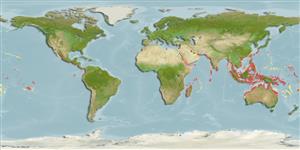Klassifizierung / Names
Namen | Synonyme | Catalog of Fishes(Gattung, Arten) | ITIS | CoL | WoRMS | Cloffa
Environment: milieu / climate zone / depth range / distribution range
Ökologie
seewasser; süßwasser; brackwasser demersal; katadrom (Ref. 46888); tiefenbereich 0 - 5 m (Ref. 86942). Tropical; 30°N - 35°S, 24°E - 138°W
Indo-Pacific: Persian Gulf (Ref.80050) and Red Sea to Samoa, north to Japan. Collected at Natal, South Africa (Ref. 11228).
Size / Gewicht / Alter
Maturity: Lm ? range ? - ? cm
Max length : 40.0 cm SL Männchen/unbestimmt; (Ref. 9812); common length : 25.0 cm TL Männchen/unbestimmt; (Ref. 9812)
Rückenflossenstacheln (insgesamt): 4 - 5; Rückenflossenweichstrahlen (insgesamt): 8-9; Afterflossenstacheln 3; Afterflossenweichstrahlen: 9. Dark greenish dorsally, brownish over head, white ventrally; 3-6 indistinct, dark stripes along upper rows of scales; greyish dorsal fins; caudal fin bluish with black margin (Ref. 9812). Yellowish pectoral fin and may have a blue spot at fin origin (Ref. 9812).
Form schools in shallow coastal waters and enters lagoons, estuaries, and fresh water to feed (Ref. 9812). Juveniles may enter rice fields and mangroves (Ref. 9812). Feed on small algae, diatoms and benthic detrital material taken in with sand and mud; fry take zooplankton, diatoms, detrital material and inorganic sediment (Ref. 9812). Oviparous, eggs are pelagic and non-adhesive (Ref. 205). Spawning occurs at sea. Also caught with stakenets (Ref. 9812). Marketed fresh and salted.
Life cycle and mating behavior
Geschlechtsreife | Fortpflanzung | Ablaichen | Eier | Fecundity | Larven
Thomson, J.M., 1984. Mugilidae. In W. Fischer and G. Bianchi (eds.) FAO species identification sheets for fishery purposes. Western Indian Ocean (Fishing Area 51). volume 3. [pag. var.]. FAO, Rome. (Ref. 2830)
IUCN Rote Liste Status (Ref. 130435)
Warning: mysqli::__construct(): (HY000/1040): Too many connections in /var/www/html/includes/func_getlabel.php on line 46
Can't connect to MySQL database (fbapp). Errorcode: Too many connections
